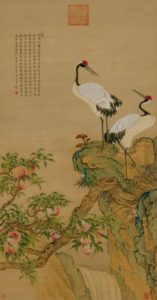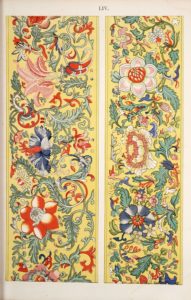Hello and welcome to this post. I will be taking a look at motifs and patterns in Chinese art.
China has a long history of art within its culture, dating back to 10000bc. Art in China much like the rest of its history is marked and influenced by the ruling dynasties of Chinese emperors. The individual dynasties tended to hold power for several centuries so the Art of their era became firmly established.
The great artistic elements to chinese art are calligraphy, poetry and painting. All of these things are closely related, they all require a brush, ink and a surface to embellish. Until the invention of paper the Chinese artist would paint on silk.


Painting and calligraphy use the same techniques, and the same brushes dipped in ink. Traditionally there are two styles of painting.

Gong-bi meaning meticulous. A highly detailed method used when depicting figures or narrative pieces it is also used in flower and bird pieces. Not only would these pieces be detailed they were often in colour.
Ink and wash painting, shui-mo, is a more loose style which would be more commonly used in landscape painting.

The artistry of the Chinese was more about living with nature and conveying the emotion of the piece rather than an exact depiction. Not really expressionism more like understanding the necessity of Co-existence with nature. That the beauty of nature was the physical manifestation of gods work, yin the female aspect and yang the male.
Yin can also be described as passive, dark, secretive, negative and cool whereas Yang is described as active, bright, revealed, positive and hot.
The artist would try to capture the spirit of the thing they were studying and not just render a perfect copy.
There is great symbolism in Chinese art, many things are used to represent the more virtuous aspects of human nature.
For example bamboo is used to show strength of spirit but also flexibility, the spirit will bend with the weight of a trial but not break.
The pine, an extremely long lived tree is a symbol of endurance. The crane symbolizing long life and the dragon a wise, powerful and noble creature was used to represent the emperor.
It is the belief of the Daoist, that man is a crucial part of nature and its rhythms and that a close relationship with nature is beneficial to the moral and physical health of the individual.
Symbolism is huge in Chinese art, literally every picture tells a tale.
The Top 5 animal symbols
1, the crane, hope, peace, longevity, joy, good luck and healing.
2, Turtles, long life.
3, Carp, good luck and strength.
4, Lions, good fortune and prosperity.
5, Deer wealth and long life


The Top five fruit
1, The orange happiness
2, The pomegranate fertility
3, The apple peace
4, The pear prosperity
5, The Peach long life good health and sex
The Top five colours
1, Red and orange happiness and celebration
2, White purity, death and mourning
3, Yellow and Gold heaven and the emperor also Mourning
4, Green harmony
5, Grey and Black death and mourning

As can be seen with the above lists the central theme is longevity. The confusion value of respect and veneration of elders ensured that a long life or the search for immortality was actively pursued. By the time we reach the Ming (1368 – 1644) and the Qing (1644 1911) dynasties there were fundamental motifs throughout painting, poetry and calligraphy.